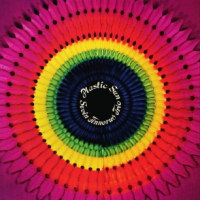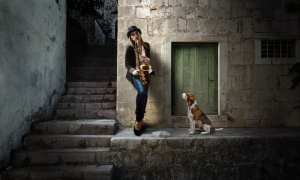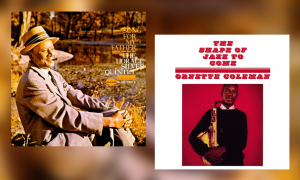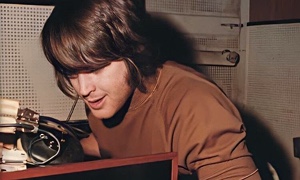Home » Jazz Articles » Building a Jazz Library » From George Coleman to Meeco: Ten Overlooked Classics
From George Coleman to Meeco: Ten Overlooked Classics

 Meeco
Meeco Beauty Of The Night
Connector
2012
Berlin-based composer/producer Meeco and his singular satin jazz share approximate bearings with two other artists. One is Antonio Carlos Jobim, for the influence of bossa nova on Meeco's songwriting and the heart-on-sleeve romanticism that his writing shares with Jobim. The second is Astrud Gilberto, who is suggested by Meeco's first-call singer, Brazil's Eloisia. That said, Meeco is more jazz centered than Jobim or Gilberto. Beauty Of The Night, his third album, evokes the jet age's glamorous conflation of Rio de Janeiro, New York and the Côte d'Azur, a vibe the albeit fleeting presence of chanteuse Jane Birkin does nothing to diminish. The instrumental lineup includes longtime Meeco collaborators, pianist Kenny Barron and bassist Buster Williams. Joining them are trumpeter Eddie Henderson, alto flautist Hubert Laws, tenor saxophonist Benny Golson, bass clarinetist Bennie Maupin, vibraphonist Stefon Harris, drummer Victor Lewis and guitarists Lionel Loueke and Romero Lubambo. There are Jacques Morelenbaum cello arrangements on four of the eight tracks. Along with Eloisia and Birkin, vocalists include Freddy Cole and Gregory Porter. Jazz is only rarely as elegant as it is on Beauty Of The Night. Also recommended: Souvenirs Of Love (Double Moon, 2015).
 Howard McGhee Sextet
Howard McGhee Sextet Howard McGhee Vol. 2
Blue Note
1953
The word "trippy" had not been coined in 1953, but it lends itself to several tracks on trumpeter Howard McGhee's second outing on Blue Note. The album is a magical affair full of life and light and unexpected refractions. Partly this is down to the impeccable choice of sidemen: alto saxophonist and flautist Gigi Gryce, guitarist Tal Farlow, pianist Horace Silver, bassist Percy Heath and drummer Walter Bolden. When the album was recorded, in spring 1953, all six musicians were rising stars on the New York scene (including Bolden, though he is less well remembered in 2022). McGhee and Gryce were both gifted composer/arrangers—each contributes two scores here—as was Bolden, who contributed one. The sixth track is a cover of Gordon Jenkins' "Goodbye." The playing is immaculate and the solos are concise, a necessity given the number of strong players and the 10" format of the original release. Blue Note reissued the album on CD in 1998 as part of its Connoisseur series, partnered with Tal Farlow Quartet, a 10" recorded in 1954, featuring the hot young drummer Joe Morello.
 Dudu Pukwana & Spear
Dudu Pukwana & Spear In The Townships
Caroline
1974
Before he formed his London-based band Spear, alto saxophonist Dudu Pukwana was part of South African sextet the Blue Notes, which toured the country in open defiance of its apartheid laws. Pianist Chris McGregor was white and the other musicians were black and multiracial bands were illegal. After a year and a half of incessant police harassment, the Blue Notes went into European exile while appearing at the 1964 Antibes Jazz Festival. After a few peripatetic months, five of them settled in London (tenor saxophonist Nick Moyake returned home). In The Townships was the debut album from Spear, the all-South-African-exiles quintet Pukwana formed with fellow Blue Notes trumpeter Mongezi Feza and drummer Louis Moholo-Moholo plus tenor saxophonist Bizo Mngqikana and bassist Harry Miller. The music is a groove-based hybrid of free jazz and kwela, exploding with energy and insurrection, a full tilt fuck-you directed at the South African regime. Check the YouTube clip below. R.I.P. Growing up under apartheid and then becoming exiles took a heavy toll on the Blue Notes. Nick Moyake passed in 1969 aged 35. Mongezi Feza passed in 1975 aged 30. Bassist Johnny Dyani passed in 1986 aged 40. Dudu Pukwana and Chris McGregor both passed in 1990, aged 51 and 53 respectively. Only Moholo-Moholo, still with us, lived to see the fall of apartheid.
 Zoe & Idris Rahman
Zoe & Idris Rahman Where Rivers Meet
Manushi
2008
In 2008, the Bengali folk and film music-inspired Where Rivers Meet introduced a new direction for London-based pianist Zoe Rahman and her clarinetist/saxophonist brother, Idris. Both were born and brought up in Britain by a Bengali father and English mother. The first sign Zoe gave of an emerging interest in Bengali music was on her Mercury Prize-nominated album Melting Pot (Manushi, 2006), whose closing track was an arrangement of the popular song "Mucche Jaoa Dinguli." Idris' work had been more culturally diverse, not least with his band Soothsayers, whose Tangled Roots (Red Earth Records, 2006) was a rousing celebration of Jamaican and West African music. Where Rivers Meet is neither pure jazz nor standard-issue world music. It is best described as chamber jazz hybridized with Bengali popular music. It is a vibrantly melodic affair, by turns joyful and sad and always intensely pretty. The core of the group is Zoe, Idris and tabla player Kuljit Bhamra, augmented by bassist Oli Hayhurst, drummer Gene Calderazzo and violinist Samy Bishai. Where Rivers Meet, by the way, shares a similar title to Where The Rivers Meet (Redgold, 2000), another luminously beautiful suite featuring Bengali singers Lucy Rahman and Akah Sultan, written for the London big band Grand Union Orchestra by its founder, the Bengali music aficionado Tony Haynes.
 Michel Legrand
Michel Legrand Legrand Jazz
Columbia
1958
Strictly speaking, Michel Legrand's Legrand Jazz is not overlooked. It is lauded whenever it is mentioned. But fewer people seem to have actually heard the album than have merely heard of it. The composer of many fine film soundtracks, Legrand here shows himself to be a master of jazz big-band arranging, too. The eleven tracks are all familiar jazz standards—from Fats Waller, Django Reinhardt, Dizzy Gillespie, Duke Ellington, Thelonious Monk and six of their peers—but Legrand breathes new life into the tunes with imaginative arrangements and sometimes unexpected tempos (Bix Beiderbecke's "In A Mist" is taken at a furious pace). The soloists are similarly invigorating. Miles Davis and Bill Evans are featured on Waller's "Jitterbug Waltz," Ben Webster on Reinhardt's "Nuages," John Coltrane on John Lewis's "Django," and Herbie Mann, Phil Woods, Art Farmer, Frank Rehak and Ernie Royal are among those spotlighted elsewhere. Trainspotters will note that Teo Macero plays baritone saxophone on three tracks. Legrand Jazz was recorded over three sessions in New York in summer 1958, within a few weeks of photographer Art Kane's A Great Day In Harlem portrait and with a collective cast of thirty-one musicians, many of whom were present at both events.
 Nicola Conte
Nicola Conte Other Directions
Blue Note
2004
Nicola Conte is best known for his early acid-jazz work, in particular his genre-defining masterpiece, Jet Sounds (Schema, 2000), and his post-2010 spiritual jazz albums. Other Directions is the most straight-ahead of his discs. Conte has said that it is his tribute to Horace Silver, John Coltrane, Miles Davis, Cannonball Adderley, the Kenny Clarke-Francy Boland Big Band, Bill Evans and Yusef Lateef. It is performed by a mid-sized band assembled from A-list Italian jazz musicians. The arrangements have poise and world-class soloists abound, including alto saxophonists Rosario Giuliani and Gaetano Partipilo, tenor saxophonist Daniele Scannapieco, trumpeter Fabrizio Bosso and trombonist Gianluca Petrella, a Conte collaborator from the acid-jazz years. Twelve of the fourteen tunes are Conte originals. The two covers debuted on soundtracks for European art-house films. "All Gone," composed by British saxophonist John Dankworth with lyrics by playwright Harold Pinter, is from Joseph Losey's The Servant (1963); "Le Depart," by Krzysztof Komeda, is from Jerzy Skolimowski's The Departure (1966). Other cross-art references include Beat novelist Jack Kerouac, whose eponymous book inspired Conte's "Dharma Bums."
 Alessandro Meroli
Alessandro Meroli Notturni
Space Echo
2021
Jazz has an impressive track record for film scores. But curiously, given the many movie masterpieces shot by Italian directors, the country has produced few jazz-based soundtracks of note. Saxophonist and composer Alessandro Meroli's Notturni would certainly qualify except for one thing: there is no film. It is, however, an audio album crying out to be a soundtrack. Ideally this would be a visual tone poem along the lines of director Godfrey Reggio's collaboration with Philip Glass on 1982's Koyaanisqatsi, for Meroli's Notturni needs neither dialogue nor narration to tell a story. It starts out evoking crepuscular romance, then moves through Edward Hopper small-hours isolation and Albert Hitchcock nightmares, before concluding in the hope-filled dawn of a new day. One of the tracks is dedicated to Hitchcock's go-to composer, Bernard Herrmann. Meroli says the music was partly inspired by Louis-Ferdinand Céline's 1932 novel Journey To The End Of The Night. Other inspirations seem to be Duke Ellington, David Axelrod, Albert Ayler, Yusef Lateef and Ravi Shankar. Notturni's mix of jazz, psychedelia, electronica, Bollywood and classical-contemporary could be dubbed long-form acid jazz, and it is appropriate that it is released on Space Echo, a sister label of Milan's Schema, the home of Nicola Conte since Jet Sounds in 2000.
 Svein Finnerud
Svein FinnerudPlastic Sun
Sonet
1970
From the early years of Norwegian jazz, few albums have stood the test of time as well as the synchronously psychedelic Plastic Sun. It was the second release from the Svein Finnerud Trio—pianist Finnerud, bassist Bjørnar Andresen and drummer Espen Rud—which was a prominent presence on the Norwegian avant-garde scene in the late 1960s and early 1970s. The group pioneered ideas that later found an international audience through ECM artists such as Jan Garbarek, Arild Andersen and Terje Rypdal. The trio itself never recorded for ECM, however, because by the time Manfred Eicher's label hit its stride, Finnerud was more involved with painting than with music. Plastic Sun spans a broad stylistic range, from funk and gospel-infused interludes through proto-ambient meditations and turbocharged collective-improvisations. It is an acoustic album, but the soundscape is rich in timbral invention, and engineer Egil Eide, working with limited technical resources by 2022 standards, was key to crafting the psychedelic vibe. In interviews, Finnerud acknowledged the formative influence of Paul Bley and his trios; two of the tunes on Plastic Sun, "Cartoon" and "Touching," were written by Annette Peacock, Bley's then wife. Another inspiration was Ornette Coleman, whose "Dee Dee" is also included.
 George Coleman
George Coleman Amsterdam After Dark
Timeless
1979
"That lovely, lovely sound," Stan Getz was famously heard to murmur. He meant, of course, his own sound, bless him, but the words also fit George Coleman, one of modern jazz's most underappreciated tenor players. Coleman's Amsterdam After Dark was actually recorded in the studio in New York, in December 1978. The title is that of the blues-based Coleman tune (one of four originals) which opens the album. A more appropriate title might have been taken from another track, Vernon Duke's "Autumn In New York." But anyway. What matters is that the album is solid gold, presenting Coleman's unique blend of plangent lyricism and full-throated muscularity to superb effect. While he continues to be celebrated for his contributions to Miles Davis' quintet in 1963-64, Amsterdam After Dark is an even better showcase—there is no second horn getting in the way, just in the zone accompaniment from pianist Hilton Ruiz's trio with bassist Sam Jones and drummer Billy Higgins. Listening to the album, one wonders yet again why Coleman has never attracted more than a niche following. The answer probably lies in his non-careerist attitude to music. In an AAJ interview with R.J. DeLuke in 2002, Coleman said: "There are certain people that are well publicized. Me, I've always been in the background. I've never been bitter about it... I've played with some of the great players in the business. Didn't sound too bad. Made a few records of my own. With all these things, I feel like I can retire and be happy."
 Ilaria Capalbo
Ilaria Capalbo Karthago
Bluenord
2022
At the time of writing in spring 2022, bassist and composer Ilaria Capalbo's Karthago has barely been out long enough to qualify as overlooked. But while the album is making a dent in Europe, the chances are it lacks the distribution necessary to follow suit in North America. Born and brought up in Italy, since 2020 Capalbo has spent much of her time in Sweden, where she recorded Karthago. The album was inspired by the ancient city of Carthage, which during the age of the Roman Empire was situated in what is now Tunisia. The city is said to have been founded, unusually, by a woman and was destroyed by a Roman army in 146 BC. Enough history. The album is in effect a suite, composed and arranged by Capalbo for a quintet, which is expanded on the opening track only to a septet. The music is elegiac and sometimes poignant, but never mournful and always lyrical and shimmeringly beautiful. There are occasional solos but they are brief; the emphasis throughout is on group playing, which moves seamlessly back and forth between arranged and improvised sections, both of which feature high degrees of counterpoint and collective interaction. Alongside Capalbo, alto saxophonist and clarinetist Thomas Backman, tenor and baritone saxophonist Fredrik Nordstrom, guitarist Andreas Hourdakis and drummer Fredrik Rundqvist are together and separately key to the success of the music. An album which affirms one's faith in the future of jazz.
Tags
PREVIOUS / NEXT
Support All About Jazz
 All About Jazz has been a pillar of jazz since 1995, championing it as an art form and, more importantly, supporting the musicians who make it. Our enduring commitment has made "AAJ" one of the most culturally important websites of its kind, read by hundreds of thousands of fans, musicians and industry figures every month.
All About Jazz has been a pillar of jazz since 1995, championing it as an art form and, more importantly, supporting the musicians who make it. Our enduring commitment has made "AAJ" one of the most culturally important websites of its kind, read by hundreds of thousands of fans, musicians and industry figures every month.






















